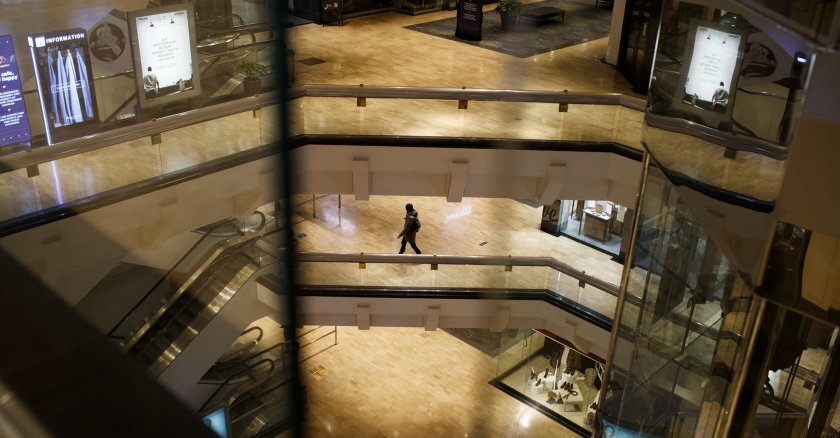In Brief:
Masks are increasingly uncommon, emergency restrictions are being lifted and death counts no longer top the daily news, but the COVID-19 pandemic and its aftermath will define American life for years to come. And few places have been as transformed by the pandemic as dramatically as big-city downtowns.
A few years ago, Tracy Hadden Loh, a fellow with the Anne T. and Robert M. Bass Center for Transformative Placemaking at Brookings Metro, began talking regularly about downtown issues with her colleague, Hanna Love, a senior research associate at Brookings Metro. The two share an office; Loh studies commercial real estate and Love studies public safety. Every time a new article was published with a headline projecting doom for office districts and downtowns, Loh says, she’d “wheel my rolly chair around” and talk it over with Love. It was like the setup to a joke, Loh says. “It’s the fall of 2021. A commercial real estate expert and a public safety expert walk into a bar. What do you think is gonna happen? They turn to each other and say, 'Dude! Downtowns! What’s going on?'”
Last fall, the two began interviewing dozens of landowners, brokers, elected officials and other members of what Loh calls the “downtown coalition” in four cities: New York, Chicago, Seattle and Philadelphia. And this spring, they’ve begun publishing a series of reports, in cooperation with other researchers at the Brookings Institution, exploring the future of American downtowns. The reports focus on perceptions of public safety and crime, real estate and vacancy, and other challenges facing cities. An upcoming report will focus on homelessness. Loh, who also serves on the board of the Washington Metropolitan Area Transit Authority, recently spoke with Governing about the research she’s doing and the mood among economic and civic leaders in cities. The conversation has been edited.
Governing: I thought it was funny that in one of your recent reports, you noted that the half-empty office districts in some big American cities are also half full. What’s your general sense of where things stand and where they’re going in downtowns? Is the glass half full to you?
Tracy Hadden Loh: I should fully disclose that I am an optimist as a person. But I think if we look at the data, whether it’s data regarding tap-ins to offices in major markets or cellphone travel data about people’s movements or transit ridership data, we see that we’re not at a plateau yet. The recovery is very slow, especially when you’re looking at aggregate data across markets.
When you look at disaggregated data focusing on specific markets, I see reasons to conclude that we have not plateaued yet. For example, the people who live Melbourne, Australia, are not an alien species that is fundamentally different from the people who live in Perth, but the office utilization rate in Perth is double what it is in Melbourne. The same thing is true in the United States. Office utilization rates in Austin are double what they are in San Francisco, even though these are both tech markets. There’s something else going on besides “Offices are over.”
Governing: I’m so curious about the interviews you’re doing. Who are you talking to and what kind of mood are folks in?
Loh: We have been interviewing basically anyone who will talk to us: major employers, major landowners, developers, brokers who represent tenants or landowners, community organizers, chambers of commerce, elected officials, community and economic development intermediaries, and some law enforcement. We did the bulk of our interviews in the fall of 2022, and to be clear, the mood has changed a lot. Chicago had a primary, and the mood shifts a lot with a campaign cycle. There are elections still to come in Philadelphia and Seattle. I’m anticipating a lot of feelings around that.
Governing: When you think about all the types of activities and interactions that cities make possible, what kind of place should downtowns be? Is it OK to just let them evolve without intervening, even if evolution looks like decline at various points?
Loh: There isn’t a single normative vision for downtowns. There’s an economic reason that we have downtowns, and that’s about agglomeration economies, and there’s a set of economic stakeholders that are involved, including major employers. But there’s all these other roles that downtowns play, and it is an open debate how important those are and how we’re going to govern those things. All the demonstrations that happened after the murder of George Floyd — where did those demonstrations happen? They happened downtown: the civic commons. If you go to the Loop in Chicago right now, the Loop Alliance is running an ad campaign called “The Loop: Everyone’s Neighborhood.” To what extent is that in conflict with the economic interests in downtowns? It’s an open question: What are these places? What do we want them to be? Who is "we"? That’s the biggest question here.
The existing downtown coalition as it stands right now, whom I’m working with on this project, has a political problem. The coalition is not broad enough. They don’t have the political base that they need. What it takes to support a downtown is frankly regional. The size of a downtown is determined by the size of the region it’s in, not by the size of the city it’s in or by the number of landowners. And you can’t just bully people into getting into these coalitions with trickle-down economics.

Governing: Your report shows that downtowns are relatively safe compared to other urban neighborhoods. And even where there are some increases in crime downtown, it’s often starting from a low baseline, so any change makes people feel like it’s worse than it is. How should city leaders respond to those changes in perception about public safety in downtown areas?
Loh: If you look at our public safety research brief you see a list of bulleted recommendations. But generally, if people are perceiving that there’s a huge increase in crime, but you know from looking at your crime data that it’s a reaction to this increase on top of a really low baseline, the perception does matter, so provide people with reassurance. People want reassurance that someone is looking at this, that someone is doing something about it, and that if they need help someone will come. If people want someone to come help when they call, make sure there’s someone. Increase the number of downtown ambassadors, for example. Pick up the trash. That makes people feel like someone is taking care of the place — some basic clean and safe stuff. Create new forms of response. There’s a mental health crisis, so create an alternative response model for mental health. It’s not like no one has ever tried anything. We already have a growing body of research demonstrating that alternative mental health response works. So let’s spread and scale that to more places.
Governing: What case is there for public intervention in downtown real-estate markets?
Loh: It’s important for cities to not rush into a heavy investment in any one solution. Cities need an all-hands-on-deck approach to how the economics of downtown are evolving, so they should create comprehensive strategies and implement them incrementally. Try stuff and see what works. Just looking at the market data, for the vast majority of cities it is too soon to conclude we have a market failure here that requires an enormous amount of public-sector intervention.
I hear people asking a lot, "Why don’t building owners just lower the rent and fill the building with tenants?" The answer is that the valuation of the building is based on the asking rents, so if they lower the rents, they lower the valuation of the building, and most of these buildings are leveraged — collateral against a loan — and that will put the owner automatically underwater on their mortgage. It’s like a game of chicken in which the question is what it’s going to take to get these buildings to reprice. Repricing is the most important piece to adaptation, but even with that there are still a lot of costs associated with adaptation. Cities should start proactively thinking about what to do in order to facilitate the adaptation. We all know it’s possible for an office building to fall into decline, fall vacant and remain vacant for a long, long time. So I’m not saying cities should do nothing. I’ve made some really specific recommendations about the best tools to get these projects moving. But some of it just has to be waited out.
Governing: What else do you want to talk about before I let you go?
Loh: We need to be cognizant of the fact that most of the major U.S. transit systems are going to be facing a fiscal cliff in the next year. So there is urgency around some parts of this conversation. Cities don’t have all the tools they need to avoid the fiscal cliff for transit systems. These are regional systems and I think that states are absolutely going to be key to the solution here, because people view a federal solution as unlikely. What are the new ways we can come together to figure out how to make this work? Our society. Our infrastructure. Our places. We have a problem that we need to figure out.













